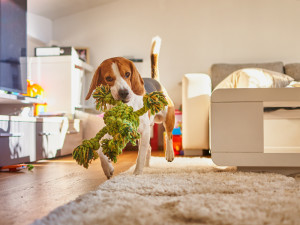Raw Dough and Dogs Don’t Mix
Active yeast puts dogs at risk for obstruction and alcohol poisoning.
Over the past couple of years, more people have taken up the delicious hobby of artisan bread baking. Leaving bread out on the counter to rise is common when baking bread. Unfortunately, one thing most pet parents don’t realize is the possible danger of rising bread dough to dogs. Some dogs are notorious counter surfers, others might simply find the temptation too hard to resist; either way, you don’t want to be that pet parent who leaves dough on the counter and comes back to missing dough and a sick dog.
If your dog has gobbled down your rising dough, they’ll require immediate veterinary care to prevent serious consequences. The risks aren’t just limited to bread dough; they apply to any unbaked rising dough which contains active yeast. Other yeast-free doughs (such as cakes and cookies) do not cause the same concerns, although cookie dough frequently contains raw eggs, chocolate chips, and/or raisins which can be toxic to dogs.
Save on the litter with color-changing tech that helps you better care for your cat.
Okay, so why is raw bread dough so dangerous for dogs?
There are two big reasons why eating raw dough is unsafe for your dog and both relate to the presence of active yeast. The first problem with dogs eating unbaked bread dough is that dough rapidly rises after ingestion and can cause life-threatening stomach distention and obstruction. The second — and potentially more serious — risk comes from the fermentation of the yeast, which can lead to alcohol poisoning.
Any species can be susceptible to these problems, but veterinarians will see this more with dogs because of their indiscriminate eating habits. Given the opportunity, many dogs will gladly eat raw bread dough while it’s rising. They’ll snarf all that is available quickly, so they generally show up at the vet with large amounts of raw dough in their stomachs. It isn’t unheard of for a dog to eat one or two loaves, a pan of rolls, or enough dough for a large pizza in a matter of moments.
What happens when they eat bread dough?
The warm, moist environment of the dog’s stomach serves as an efficient incubator for the replication of yeast within the dough. The expanding dough mass causes distention of the dog’s stomach, which compromises blood circulation in the body. The continued enlargement of the stomach can also make breathing more difficult.
During yeast fermentation, ethanol is produced (alcohol), which is absorbed into the dog’s bloodstream, resulting in intoxication and potentially life-threatening disturbances to a dog’s system. So, not only will your dog be bloated and painful, but also drunk.
What are the signs of unbaked dough ingestion?
Early symptoms in your dog can include unproductive attempts at vomiting, visible belly distention, and increasing depression. As ethanol intoxication develops, the dog may stagger and become disoriented. Eventually, after consuming unbaked dough, the dog may show profound neurological depression, weakness, coma, low body temperature, or seizures. Toxicity can be fatal, and death is usually due to the effects of alcohol rather than stomach distention. However, the potential for the dough to trigger life-threatening Gastric Dilatation and Volvulus (GDV or “bloat”) or intestinal obstruction should not be overlooked.
Symptoms:
Unproductive vomiting
Stomach distension
Weakness
Disoriented or unsteady
Depression
Hypothermia
Seizures
Coma
Diagnosis
Blood alcohol levels can be obtained through a laboratory but are generally not used in a veterinary setting. A presumptive diagnosis is usually made based on the pet parent’s information and the dog presenting with symptoms. Other health issues with similar symptoms include GDV, other intestinal foreign bodies, ethylene glycol ingestion (antifreeze), and ingestion of antidepressants.
Treatment for Unbaked Dough Obstruction
If your dog has just eaten raw dough and has not yet shown symptoms, veterinarians may induce vomiting. The glutinous nature of bread dough may make removal by vomiting difficult.
In dogs where vomiting has been unsuccessful, gastric lavage may be attempted. This is where a veterinarian “flushes” the dog’s stomach with water while he is under anesthesia. Cold water introduced into a dog’s stomach through a tube during lavage may slow the rate of yeast fermentation and aid in the removal of the dough.
IV fluids and serial X-rays may be required to monitor the passage of the dough and to ensure no complications develop. Surgical removal of the dough mass may also be necessary if a large amount has been ingested.
Treatment for Alchohol Toxicity in Dogs
Dogs that show additional signs of alcohol toxicity first need to be stabilized and have any life-threatening conditions corrected before attempting to remove the dough. Alcohol toxicity is managed by correcting metabolic problems, managing heart abnormalities, and helping the pet maintain their normal body temperature. Fluid therapy is administered to help enhance the elimination of alcohol from the bloodstream.
Aside from a hangover, most dogs make a full recovery in 36 hours if they receive treatment quickly. As always, prevention is the best treatment: If you have a fabulous baker in your home, be extra conscientious while leaving the dough to rise. Be sure to safely store baking goods away from dogs and watch for counter-surfing pups.
As always, prevention is the best treatment: If you have a fabulous baker in your home, be extra conscientious during the rise! Be sure to safely store baking goods away from dogs and watch out for counter-surfing pups.






